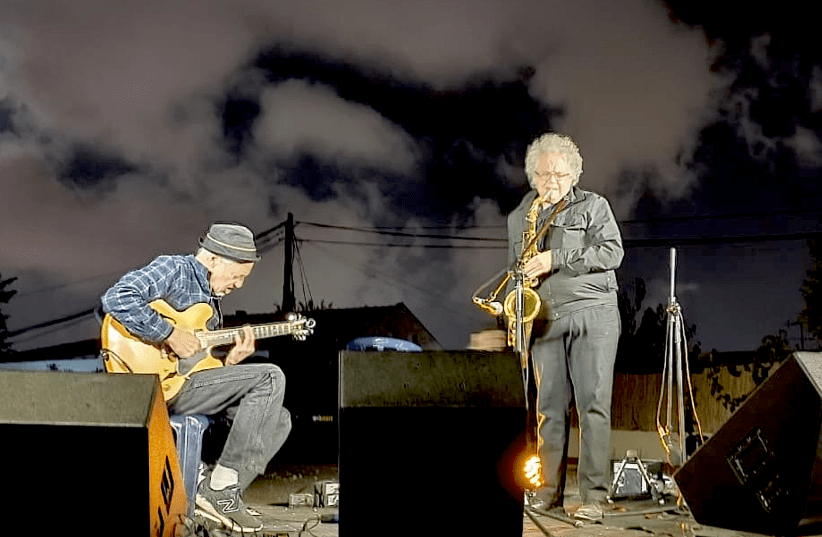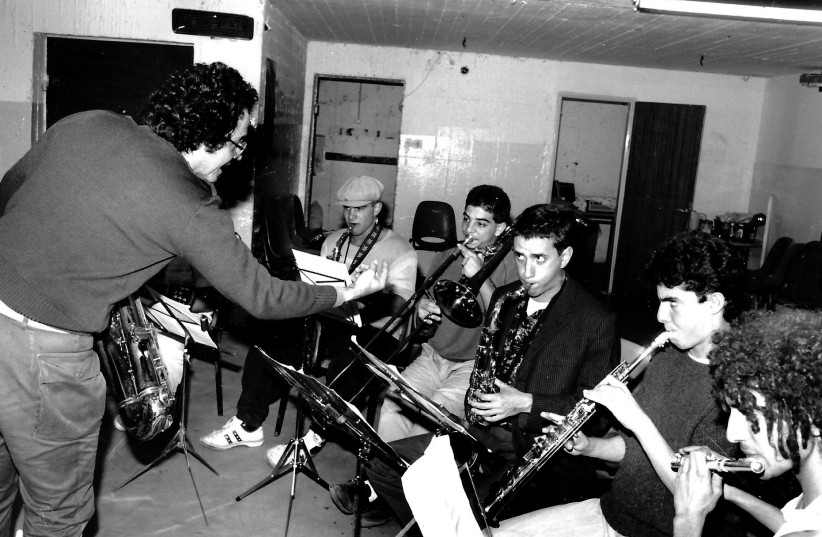It has been said that as long as you still have something in the pipeline, you’re not old. If that is the case, then Dr. Stephen Horenstein is happily entrenched in his youth.
In a couple of months’ time, the US-born, longtime Jerusalem-resident multi-instrumentalist, composer and educator turns 75. That’s quite a milestone, and what better way for a musician to celebrate than to get together a multigenerational bunch of like-minded artists to get down and dirty, in the best possible off-the-cuff musical sense?
Horenstein has put together a four-date program for the occasion, which he has called the Music on the Edge Festival. The gig schedule takes in a duet with American-born guitarist Steve Peskoff at the Hamifletzet Pub in Kiryat Hayovel on February 23 (8:30 p.m.) when the longtime sparring partners put their wise heads and seasoned hands together to run through some ideas that have been percolating over the past 20 years.
“We are planning to record an album based on this. It’s about time we got around to recording.”
Dr. Stephen Horenstein
“We are planning to record an album based on this,” Horenstein says. “It’s about time we got around to recording,” he chuckles.
Who else is performing?
The festival lineup also includes the two-hour New Directions slot on the morrow, starting at 1:30 p.m. at the Sedek cooperative arts outfit in Alliance House near the Mahaneh Yehuda market. That features members of Horenstein’s Lab Orchestra and the Sedek gang and will be a typically free-flowing instinctive endeavor.
The leader talks about “composers-performers” playing in twos and threes, works that are “composed in real time for the occasion.” That is characteristic of the man who has been pushing the envelope and jumping off artistic cliffs without a parachute for half a century.
But none of that might have happened in this part of the world without the help of a certain well-known man of letters. In truth, there were a couple of other factors that prompted Horenstein’s relocation from his comfy existence in Vermont. “Some of my former students decided to come here,” he tells me when we meet up in a café on Emek Refaim Street which, apparently, in a previous structural incarnation, was an apartment that served as the reedman’s first home here. “My grand piano used to be where the kitchen now is,” he laughs.
Residential logistics aside, it seems that a couple of Horenstein’s former students from Bennington College, a liberal arts educational institution in Vermont, had made aliyah. “They told me, ‘Why don’t you come here? There are all sorts of interesting people here,” he recalls.
The time for a move, physical and otherwise, was ripe. Horenstein was at a personal and artistic crossroads. He also had time on his hands. “I had a sabbatical coming up, and I was at a loose end. I didn’t know what I should do with my life.”
He deliberated over a couple of very different destinations. “I had spent 10 years at Bennington, and I had just broken up with someone,” he says. It was time to get his proverbial rear end in gear, and he got a shove in this direction from a fellow, highly celebrated, faculty member.
“The [Pulitzer Prize laureate] writer Bernard Malamud taught at the college. I could have gone to Paris – a place of love – or Israel. Bernard said, ‘You’ve got to get out of here, and you’ve got to go to Jerusalem.” Israel it was.
He came here with hefty artistic baggage, significantly informed by Bennington College teacher and free jazz community leader trumpeter Bill Dixon, and was inspired by the likes of American experimental modernist composer Charles Ives. But, like South African-born painter and clarinetist Harold Rubin, who also walked the wilder side of the creative tracks before making aliyah in the early 1960s, Horenstein found very little to spark his artistic interest here.
“In that sense, when I came here, for creative players it was basically like coming to a desert. I had been taught for 10 years by my mentor that you live in the present. That’s the meaning of On the Edge,” he says, referencing the festival moniker which was also the title of some of Horenstein’s previous collaborative ensemble projects.
That ties in neatly with the idea of creating on the fly, never knowing what the next note would be and where it would lead. It also obliges anyone else you are playing with to be attentive and tuned in to what is going on around them. “You don’t play anything that you know,” he observes. “You don’t play patterns. I learned not to repeat patterns. You play what you hear, in the present.”
Hornstein: A nack for seizing opportunity
IN ADDITION to being blessed with an adventurous musical spirit, it transpires that Horenstein also has a healthy knack for spotting an opportunity and grabbing it with both hands. He not only plays what he hears, but he is fully capable of seizing the moment off stage, too.
A year or so after he made aliyah, he was sitting in the cafeteria of the Israel Museum, minding his own business, when he overheard a discussion between a couple of senior museum employees. At that point, Horenstein felt he had, again, run into a dead end. “I didn’t know what my next step was going to be. I was teaching in Kiryat Malachi at the time.”
It seemed that a grand artistic plan was afoot. “They were talking about what they were going to do in the summer. They had a vision of creating a huge event in the Billy Rose Garden [on the museum grounds]. They took some choreographers, one was [now 84-year-old] Rina Schenfeld.”
Horenstein immediately latched on to that. He felt he had some street cred to offer. “I worked in the dance department at Bennington. I was a musician in residence. I said to myself, ‘If I don’t do something, I’m going to lose an opportunity.’”
The new oleh sprang into action, mustering a decent dose of chutzpa. “I just got up and said, ‘I overheard your conversation. If you bring me onto the project, I can compose all the music for every choreographer so that when they are played simultaneously, it will be one piece. It will also change, depending on where you are in the garden because of the way sound travels.’”
That was nothing short of brazen gall. I presumed Horenstein had prior experience with that sort of creative work. “I had never done anything like that,” he laughs. “I had done some site-specific pieces but never anything that grandiose.” Amazingly, it did the trick. They went for it. “That piece, ‘The Seven Faces of a Garden,’ put me on the map,” Horenstein notes.
Over 40 years since he decided to take a chance on Jerusalem, Horenstein is responsible for setting several generations of budding risk-taking Israeli musicians on the path to the wide open spaces of unfettered creation. Quite a few of them will play a part in the festival proceedings.
The Lab Orchestra gig that closes the program at the Yellow Submarine on March 9 (9 p.m.) focuses on Wheels Within Wheels, which Horenstein describes as “a new, extended work for 15 players gleaned from three decades of talent.” The cast for the festival finale includes the likes of trumpeter Tal Abraham; saxophonist Elinoam Warshavsky; baritone saxman and bass clarinet player Bob Trachtenberg – a veteran of numerous musical jousts with Horenstein; drummer-percussionist Hagai Fershtman; and bassist Ehud Etun.
Etun, today a respected educator himself who runs the Internal Compass Institute for Jazz in Mitzpe Ramon, says he learned a lot from Horenstein on more than one occasion. “I was in the same class as Steve’s son Yona at the Reut School in Jerusalem,” he explains. “When we were in ninth grade, Steve came to give us a lecture about [legendary jazz saxophonist John] Coltrane. No one had ever heard of him before,” Etun laughs.
The budding bassist came into Horenstein’s orbit of enlightenment a second time as an arts high school student when he attended a workshop on improvisation that Horenstein presented. “It was pretty cool,” he says.
Etun got the most from his then-mentor when he served as his assistant on a music program Horenstein had set up at a high school in Lod. “I graduated from school in June, and I had until April before I started my army service. So I decided to do something to progress with my music. I went with him to Lod three or four times a week. It was an incredible experience for me.”
In fact, the teenager got something of an all-round on-the-job education. “Steve does everything with the utmost seriousness. So much of what I do today is influenced by what I learned from him then.”
Horenstein continues to contribute to Etun’s sphere of operations. “He comes to Mitzpe Ramon to teach our students,” he says. “Steve has such presence. When he walks into a room, he captures the whole scene. He leaves our students with their mouths hanging open.”
Etun feels that the Israeli music sector, particularly the freer side, is blessed by having Horenstein around. “He is the first visionary I encountered, an American-style visionary who says ‘Let’s shoot for the moon, and we’ll go to follow one of the stars.’ The scene here would be very different without him.”
MORE THAN four decades since he snubbed Paris, Horenstein has built up an unrivaled portfolio of trailblazing ventures as a teacher at the Jerusalem Academy of Music and Dance, and as head of the Jerusalem Institute of Contemporary Music (JICM), which he founded in 1988.
He has written, performed and conducted a wide spread of works for large and small ensembles and soloists, often incorporating electronics into the acoustic textures. He has collaborated with top artists from all kinds of disciplines and media, including iconic American sculptor and landscape architect Isamu Noguchi.
He sees the JICM as a vehicle for bringing contemporary left-field music to wider audiences through performance, research and education. The institute has enriched the cultural life of Jerusalem, while creating cutting-edge artists, he notes.
The credentials for that claim are evident up and down the country and will be on show in Jerusalem over the next few weeks.
While Horenstein may not be exactly in the A-lister showbiz league and hasn’t quite made it to the Grammys yet, he has stuck to his artistic guns and never compromised on his creative credo. “When I was younger, a teacher told my class that he was going to teach us a lot of incredible stuff, how to create music, but he couldn’t promise us we would be financially independent.”
Somehow, Horenstein has kept his artistic faith through thick and thin, spreading the good adventurous word far and wide. “He is crazy,” says Etun, “in a great way.”
The evidence of that “craziness” is out there, and the soon-to-be 75-year-young Horenstein shows no signs of slowing down any time soon.
“There are so many great young talents around,” he says. “We started the Lab Orchestra, in a shelter in Kiryat Hayovel in 1986 or ’87. The kids just blossomed and became an incredible ensemble.”
Horenstein’s boundary-flexing line may not be everybody’s cup of tea, but it is art at its most elemental and purest. For that, at the very least, he deserves a resounding pat on the back.
The Music on the Edge Festival opens on February 20 with the “Live Forum of Ideas for Real-time Musical Creators” at Sedek, with composers-performers getting into earnest discourse about the way forward. Could be an eye- and ear-opener for us all. ❖
Entry to all events is free. For more information: www.facebook.com/SEDEK.group, www.hamiflezet.org, yellowsubmarine.org.il and horen52@yahoo.com














